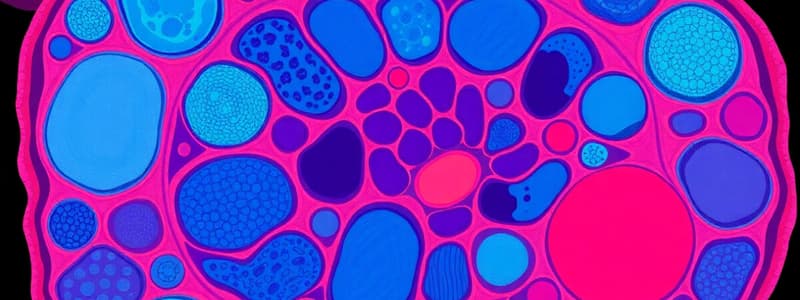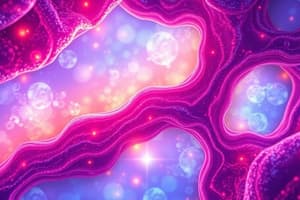Podcast
Questions and Answers
Which type of epithelial tissue is specialized for stretching and is typically found in the bladder?
Which type of epithelial tissue is specialized for stretching and is typically found in the bladder?
- Stratified squamous
- Simple columnar
- Simple cuboidal
- Transitional (correct)
What characteristic of epithelial tissue indicates it has an exposed surface?
What characteristic of epithelial tissue indicates it has an exposed surface?
- Avascularity
- Polarity (correct)
- Cellularity
- Regeneration
Which of the following types of simple epithelium is primarily involved in the absorption of nutrients?
Which of the following types of simple epithelium is primarily involved in the absorption of nutrients?
- Simple cuboidal
- Simple squamous
- Pseudostratified columnar
- Simple columnar (correct)
Stratified cuboidal epithelium is most commonly found in which location?
Stratified cuboidal epithelium is most commonly found in which location?
What is NOT a primary function of epithelial tissue?
What is NOT a primary function of epithelial tissue?
Which type of simple epithelial tissue appears to have multiple layers but is actually a single layer?
Which type of simple epithelial tissue appears to have multiple layers but is actually a single layer?
What characteristic allows epithelial tissue to rapidly replace damaged cells?
What characteristic allows epithelial tissue to rapidly replace damaged cells?
Which type of stratified epithelium provides protection against abrasion and is typically found in the skin?
Which type of stratified epithelium provides protection against abrasion and is typically found in the skin?
Flashcards
Epithelium
Epithelium
Tissue that forms a protective layer on body surfaces, lines cavities and organs, and constitutes glands.
Simple Squamous Epithelium
Simple Squamous Epithelium
Single layer of flat cells; found in alveoli and blood vessels for diffusion.
Simple Cuboidal Epithelium
Simple Cuboidal Epithelium
Single layer of cube-shaped cells; found in glands and kidney tubules for secretion and absorption.
Simple Columnar Epithelium
Simple Columnar Epithelium
Signup and view all the flashcards
Pseudostratified Columnar Epithelium
Pseudostratified Columnar Epithelium
Signup and view all the flashcards
Stratified Squamous Epithelium
Stratified Squamous Epithelium
Signup and view all the flashcards
Transitional Epithelium
Transitional Epithelium
Signup and view all the flashcards
Regeneration (Epithelium)
Regeneration (Epithelium)
Signup and view all the flashcards
Study Notes
Definition
- Epithelium: A type of tissue that forms the protective layer on body surfaces, lines cavities and organs, and constitutes glands.
Types of Epithelial Tissue
-
Simple Epithelium
- Composed of a single layer of cells.
- Types:
- Simple squamous: Flat cells; found in alveoli and blood vessels.
- Simple cuboidal: Cube-shaped; found in glands and kidney tubules.
- Simple columnar: Column-shaped; lines digestive tract.
- Pseudostratified columnar: Appears stratified but is a single layer; found in respiratory tract.
-
Stratified Epithelium
- Composed of multiple layers of cells.
- Types:
- Stratified squamous: Protects against abrasion; found in skin and mucous membranes.
- Stratified cuboidal: Rare; found in some glands.
- Stratified columnar: Rare; found in certain glandular ducts.
-
Transitional Epithelium
- Specialized for stretching; found in the bladder.
Functions
- Protection: Shields underlying tissues from mechanical injury, pathogens, and chemical exposure.
- Absorption: Nutrient uptake in the intestines.
- Secretion: Production of substances like mucus and hormones by glands.
- Sensation: Contains sensory nerve endings.
Characteristics
- Cellularity: Composed almost entirely of cells with minimal extracellular matrix.
- Polarity: Has an apical surface (exposed to environment) and a basal surface (attached to underlying tissue).
- Attachment: Basal surface is anchored to the basement membrane.
- Avascularity: Lacks blood vessels; nutrients obtained via diffusion.
- Regeneration: High regenerative capacity; rapidly replaces damaged cells.
Location
- Covers body surfaces, lines internal cavities, organs, and forms glands.
Clinical Relevance
- Abnormalities in epithelial tissue can lead to diseases such as cancer, infections, and autoimmune disorders.
Summary
- Epithelium serves vital roles in protection, absorption, secretion, and sensation, with various types adapted for specific functions and locations in the body.
Epithelium: The Protective Layer
- Forms a protective barrier on body surfaces.
- Lines cavities and organs.
- Constitutes glands.
Types of Epithelial Tissue
- Simple Epithelium: Consists of a single layer of cells.
- Simple Squamous:
- Flattened cells.
- Found in alveoli (air sacs in the lungs) and blood vessels.
- Simple Cuboidal:
- Cube-shaped cells.
- Found in glands and kidney tubules.
- Simple Columnar:
- Column-shaped cells.
- Lines the digestive tract.
- Pseudostratified Columnar:
- Appears layered but is a single layer.
- Found in the respiratory tract.
- Simple Squamous:
- Stratified Epithelium: Composed of multiple layers of cells.
- Stratified Squamous:
- Protects against abrasion.
- Found in the skin and mucous membranes.
- Stratified Cuboidal:
- Rare.
- Found in some glands.
- Stratified Columnar:
- Rare.
- Found in certain glandular ducts.
- Stratified Squamous:
- Transitional Epithelium:
- Specialized for stretching.
- Found in the bladder.
Epithelial Tissue Functions
- Protection: Shields underlying tissues from injury, pathogens, and chemicals.
- Absorption: Enables nutrient uptake in the intestines.
- Secretion: Produces substances like mucus and hormones through glands.
- Sensation: Contains sensory nerve endings.
Characteristics of Epithelial Tissue
- Cellularity: Primarily composed of cells with minimal extracellular matrix.
- Polarity: Has an apical surface facing the environment and a basal surface attached to underlying tissue.
- Attachment: Basal surface is anchored to the basement membrane.
- Avascularity: Lacks blood vessels; relies on diffusion for nutrient supply.
- Regeneration: High regenerative capacity; quickly replaces damaged cells.
Location of Epithelial Tissue
- Covers body surfaces.
- Lines internal cavities.
- Forms the lining of organs.
- Constitutes glands.
Clinical Relevance
- Abnormalities in epithelial tissue can lead to diseases such as:
- Cancer
- Infections
- Autoimmune disorders.
Summary
- Different types of epithelial tissue are adapted for specific functions and locations in the body.
- Epithelial tissue plays crucial roles in protection, absorption, secretion, and sensation.
Studying That Suits You
Use AI to generate personalized quizzes and flashcards to suit your learning preferences.




